As we continued towards Kalaw from the upper junction of Zit Zat Reverse (A), I looked back along the train and saw the 'downhill direction' fixed distant signal for the upper junction, with its arm extended the 'wrong' way.
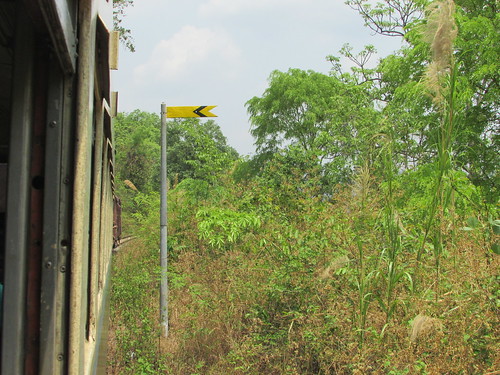 'Downhill direction' fixed distant signal for the 'Zit Zat' upper junction, with its arm extended the 'wrong' way.
'Downhill direction' fixed distant signal for the 'Zit Zat' upper junction, with its arm extended the 'wrong' way.
We passed a series of ungated, minor road crossings. Approaching each crossing, the driver sounded the locomotive horn. The train passed another village of bamboo houses. The back yards of these houses had enclosing fences close to the railway with a back gate opening onto the track. I noticed one house with an gateway covered in masses of beautiful pink flowers but with no actual gate.
The meals served at stalls on stations or by vendors travelling on the train are served in expanded polystyrene boxes. I'm afraid that, in general, the Myanmar people have no concept of 'litter' so, once the food is consumed, the plastic box is flung from the open window of the train. For some reason, it appeared that certain lengths of trackside passing through shallow cuttings seemed to be unattractively festooned with lots of cast-off boxes. I didn't notice the same concentrations of boxes when views across the mountains were available.
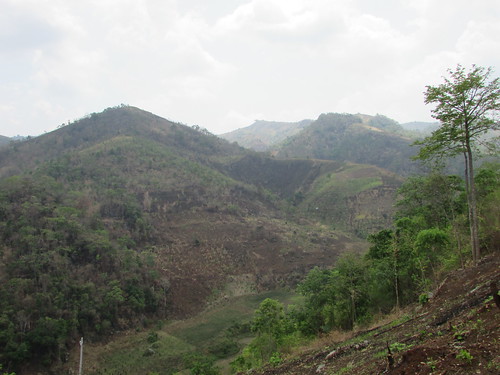 View of mountains as we approach Hkway Yok.
View of mountains as we approach Hkway Yok.
Twenty minutes after leaving the first Zig-Zag we passed a home signal (maintained at danger) and stopped at the second Zig-Zag station, named Hkwye Yok. The facilities were similar to those at the previous Zig-Zag station (but without the 'scissors' crossover). The line from Kalaw converged on our right at a turnout, then re-divided into a platform line on our left (which my train took) and a parallel siding. There was a similar proliferation of signals and an elevated ground frame beyond the end of the platform. As we slowly pulled down the platform, a growling on the right alerted me to a descending train waiting in the parallel siding - a unidentified Bo-Bo-Bo in red white and blue livery at the head of a train of empty, air-braked bogie ballast hoppers.
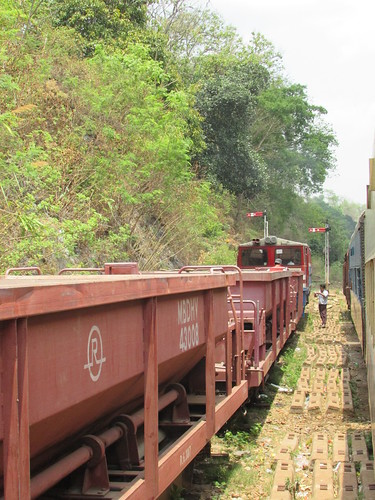
Hkway Yok Zig-Zag Lower Station, with an empty ballast train waiting to descend.
A row of food stalls lined the platform and ladies selling fruit, balanced on metal trays carried on the head, patrolled the length of the platform.
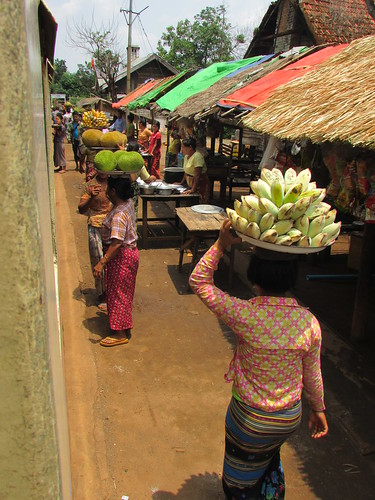
Hkway Yok station platform.
A loud 'clank' from the opposite side of the train indicated that the ballast train was restarting its descent. After a few minutes, the points had been reset and we continued our ascent, with our locomotive propelling from the rear as far as the upper junction of the zig-zag.
As we left the station, I had a better view of the elevated ground frame, an 8 lever-frame, suitable for signal box use with a conventional horizontal locking tray, but with the building omitted. Instead, a small steel platform provided with a handrail had been erected with a length of signal ladder to allow access from the ground. I was amused to note that the steel platform appeared to be second-hand pierced steel planking. Levers 1 to 6 were painted red, with the first four in the normal position, the other two reverse. Lever 7 was spare, painted white, and lever 8 was yellow. All levers except the spare were fitted with 'Trapped Key' locking boxes (there's a little more information about 'Trapped Key' locking here). Levers 1,2,5 and 6 had signal wires attached (although all the movements I saw were signalled by flag). There was no connection to the frame for point operation although one run of tubular rodding half-buried in the sand suggested that this had once been provided.

The elevated ground frame at Hkway Yok Station.
Our locomotive, working hard, propelled the train up the gradient and over the points at the upper junction, where there was an elevated ground frame as at the other zig-zag junctions, this one with an adjacent substantial hut for the operator. Frame and hut were located at the edge of a fairly precipitous drop. The ground frame was 6-lever with the usual horizontal locking tray. Some of the levers were provided with 'Trapped Key' locking boxes. Levers 1 and 2 were red, with signal wires leading away. Lever 3 was yellow, now disconnected from the cranks and tubular point rodding which once operated the single set of points. Levers 4 and 5 were also red but I only spotted a signal wire from lever 5. Lever 6, although red, was spare.
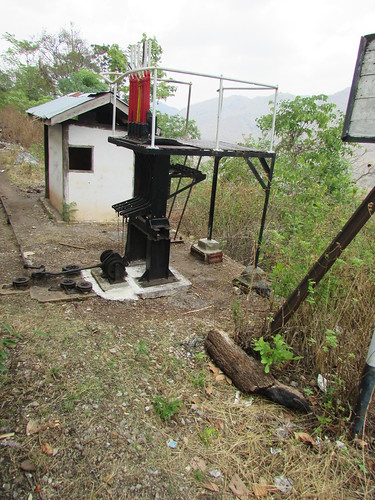
Hkway Yok Upper Zig-Zag Junction Elevated Ground Frame.
A longyi-clad pointsman, who had apparently travelled with us from Hkway Yok Station, dropped off the diesel as the train passed the points and came to a stand in the siding. Very soon, the pointsman had removed the point clip, operated the points, re-clipped them and signalled us away on our journey to Kalaw with the usual grubby green flag. The junction points themselves were provided with the usual, battered, point indicator.
 Departing Hkway Yok Upper Zig-Zag Junction, watched by the Pointsman.
Departing Hkway Yok Upper Zig-Zag Junction, watched by the Pointsman.
Whilst we waited, I noticed a semaphore signal behind our train. This was presumably for the benefit of descending trains where the locomotive would have stopped well down the siding to ensure the rear of the train had cleared the points. The signal presumably indicated when the locomotive could start to propel the train down the gradient to Hkway Yok Station. In addition to this signal, there was a home for the line from Hkway Yok Station (although I didn't spot one for trains approaching from Kalaw). There were certainly starting signals for both directions. Most of the signals had short, wooden posts, all had short corrugated arms arranged as upper quadrants but with a heavy, cast spectacle which looked designed for lower quadrant. The arm of the starting signal towards Kalaw was virtually centre-pivoted and the arm projected to the right of the post, with the spectacle on the left, so it looked very curious indeed. As expected, none of the interesting signals was operated for us, although all were quite neatly painted.
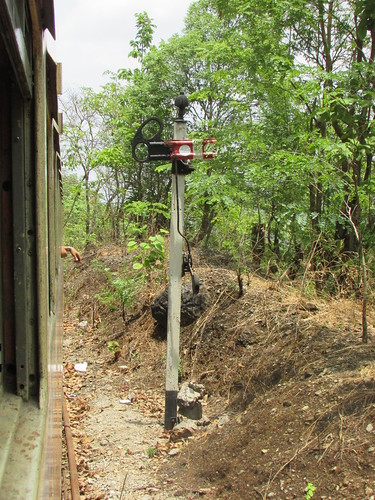
The curious starting signal towards Kalaw at Hkway Yok Upper Zig-Zag Junction.
We passed a fixed distant and the driver sounded the horn as we approached an ungated road crossing. We were treated to impressive vistas across the mountains are we continued our journey. We passed another short, corrugated arm signal with a cast lower-quadrant style spectacle this time, for variety, arranged for lower-quadrant operation but it was no surprise to be called on by a flagsignalman with a green flag. We paused at an attractive country station which I took to be Hsin Taung. A broad valley had opened on our right with a golden standing Buddha and monastic buildings visible. There was no passing loop at the station but a branch on our left as we left the station appeared to have a loop. The 'downhill' home signal had a short, corrugated arm, lower-quadrant style spectacle but arranged for upper-quadrant operation. The signal post was U-channel rolled-section. I also glimpsed a tall 'Outer Home' signal.
We were now engaged in a stiff climb over a curving route. Although I knew we were climbing, it was still a surprise to look out on the right and see the line we'd travelled about ten minutes before at right angles to our present heading and considerably lower.
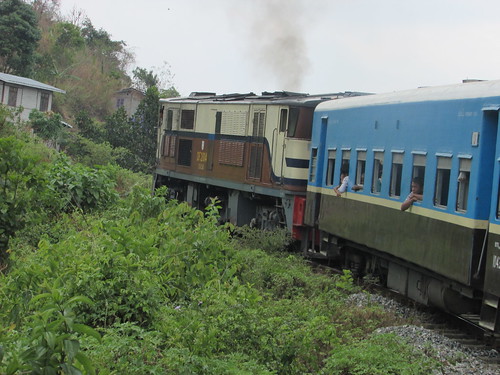 "We were now engaged in a stiff climb over a curving route".
"We were now engaged in a stiff climb over a curving route".
Once again, our route was on a 'shelf' cut into the mountain side and retaining walls were needed. Earlier ones were brick, more recent ones concrete with embedded plastic drainage tubes. Some walls featured a concrete plaque commemorating the completion date. One I noticed was '21-1-2016'. We passed through a noisy, reverberating tunnel, concrete-lined followed by more retaining walls with various dates in different styles.

Emerging from the first tunnel.
We passed through a second, short tunnel and whistled for a road crossing before a period where our speed became fairly erratic but I couldn't determine whether this was because of engineering speed restrictions or the line profile. Our route was now through paddy-filled upland. A tall Outer Home signal (unusually, in the 'off' position) indicated that we were approaching Myin Daik. Here, the leftmost track with platform and station buildings was occupied by waiting DF.2010 with a 'downhill' train. We took the loop to the right. As we stopped, I saw yellow-liveried Engineering Maintenance Car EMC.D.2 in the loop on our right.
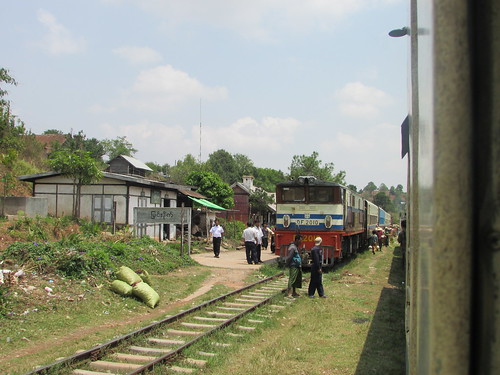 Myin Daik Station.
Myin Daik Station.
The 'downhill' train left before us, then we were off on the final eight miles to Kalaw, passing through paddies where people were working as they have done for centuries.
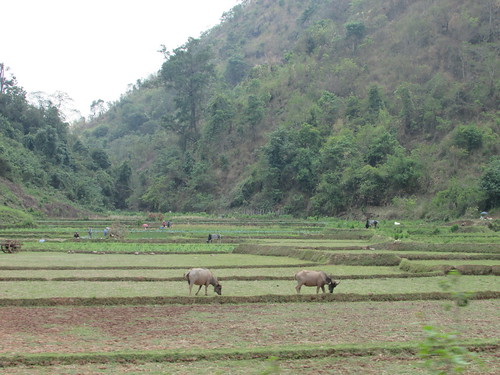 Working in the paddy fields.
Working in the paddy fields.
As we approached Kalaw, the area became more built-up. On the left, next to the railway, I spotted The Kalaw Hotel (now the Kalaw Heritage Hotel), opened by the British in 1902 then we rumbled over a road crossing and came to a halt. Another train, also hauled by a Bo-Bo-Bo, was shunting on the leftmost platform line so, again, we stopped in the loop to the right. In a siding on our right, I saw Railway Gang Car RGC/6 before struggling to the ground with my luggage. My guide, Sai Kyaw Kyaw, was waiting and instantly recognised me as the only unaccompanied elderly female tourist to disembark (I think the only tourist to disembark from the train). Kalaw has a distinctive 'Swiss Chalet' design station building so, after a few photographs, my guide took me to my accommodation after a tiring, but fascinating, journey from Thazi.
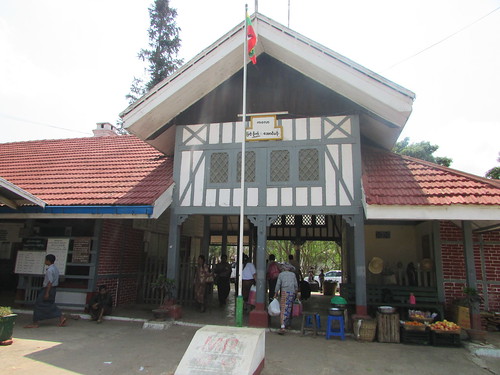 Kalaw Station Building.
Kalaw Station Building.
Related posts in my blog
Thazi-Kalaw.
Thazi Railway Station and Diesel Locomotive Depot.
All my Myanma Railways posts.
My Pictures
Pictures in this article can be viewed uncropped by clicking on the image. To view in other resolutions or download, select from the album Thazi to Kalaw by Train.
There are also a few pictures taken around Kalaw station on 5th May 2016 here.
All my Myanma Railways Pictures.
